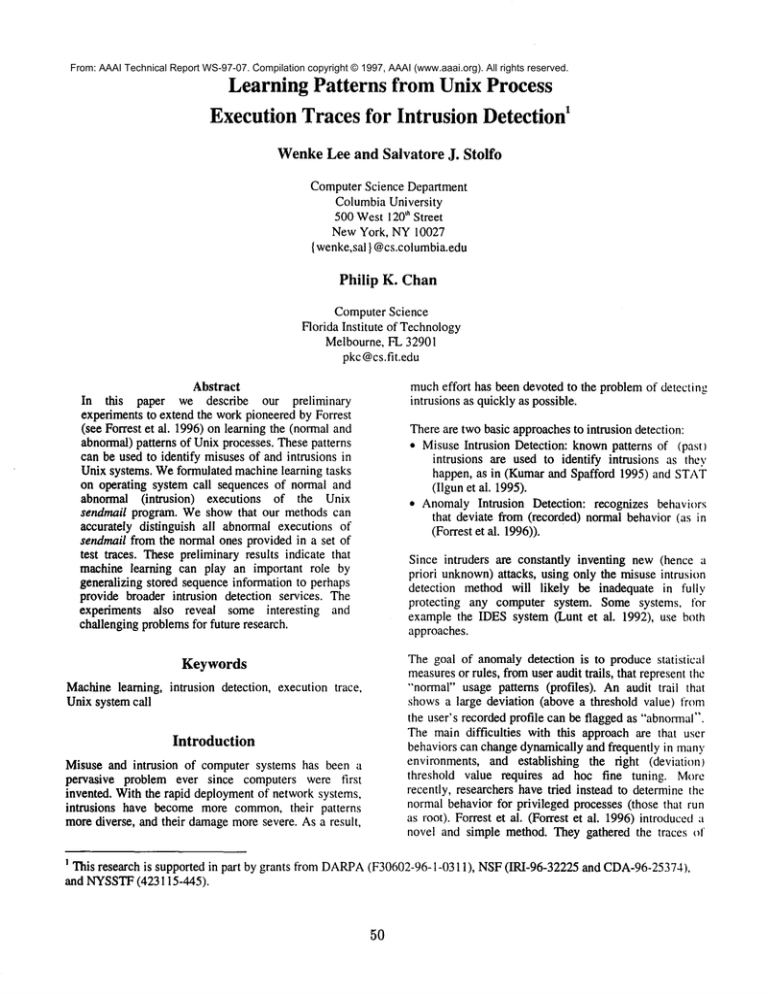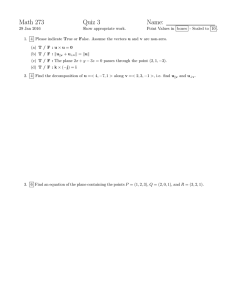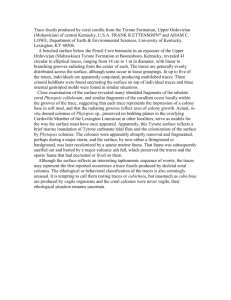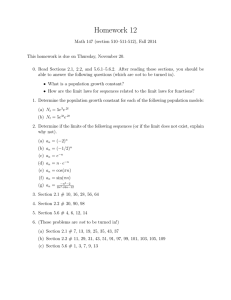
From: AAAI Technical Report WS-97-07. Compilation copyright © 1997, AAAI (www.aaai.org). All rights reserved.
Learning Patterns from Unix Process
IExecution Traces for Intrusion Detection
WenkeLee and Saivatore J. Stolfo
Computer Science Department
Columbia University
500 West 120~ Street
New York, NY 10027
{wenke,sal } @cs.columbia.edu
Philip K. Chan
Computer Science
Florida Institute of Technology
Melbourne, P’L 32901
pkc @cs.fit.edu
Abstract
In this paper we describe our preliminary
experiments to extend the work pioneered by Forrest
(see Forrest et al. 1996) on learning the (normal
abnormal) patterns of Unix processes. These patterns
can be used to identify misuses of and intrusions in
Unix systems. Weformulated machinelearning tasks
on operating system call sequences of normal and
abnormal (intrusion)
executions of the Unix
sendmail program. Weshow that our methods can
accurately distinguish all abnormal executions of
sendmail from the normal ones provided in a set of
test traces. These preliminary results indicate that
machine learning can play an important role by
generalizing stored sequence information to perhaps
provide broader intrusion detection services. The
experiments also reveal some interesting
and
challenging problemsfor future research.
mucheffort has been devoted to the problem of detecting
intrusions as quickly as possible.
There are two basic approachesto intrusion detection:
¯ Misuse Intrusion Detection: knownpatterns of (past
intrusions are used to identify intrusions as they
happen, as in (Kumar and Spafford 1995) and STAT
(Ilgun et al. 1995).
¯ AnomalyIntrusion Detection: recognizes behaviors
that deviate from (recorded) normal behavior (as
(Forrest et al. 1996)).
Since intruders are constantly inventing new (hence
priori unknown)attacks, using only the misuse intrusion
detection method will likely be inadequate in fully
protecting any computer system. Some systems, for
example the IDES system (Lunt et al. 1992), use both
approaches.
The goal of anomaly detection is to produce statistical
measuresor rules, fromuser audit trails, that represent the
"normal" usage patterns (profiles). An audit trail that
shows a large deviation (above a threshold value) from
the user’s recorded profile can be flagged as "abnormal".
The main difficulties with this approach are that user
behaviors can change dynamically and frequently in many
environments, and establishing the right (deviation)
threshold value requires ad hoe fine tuning. More
recently, researchers have tried instead to determine the
normal behavior for privileged processes (those that run
as root). Forrest et al. (Forrest et al. 1996) introduced
novel and simple method. They gathered the traces of
Keywords
Machinelearning, intrusion detection, execution trace,
Unix system call
Introduction
Misuse and intrusion of computer systems has been a
pervasive problem ever since computers were first
invented. With the rapid deployment of network systems,
intrusions have become more common, their patterns
morediverse, and their damagemore severe. As a result,
n This research is supported in part by grants from DARPA
(F30602-96-1-0311), NSF(IRI-96-32225 and CDA-96-25374),
and NYSSTF(423115-445).
50
experiments so that we can learn the effects of sequence
length on the performanceof our models.
normal runs of a programand analyzed the "local (short)
range ordering of system calls". They discovered that
these local orderings "appears to be remarkably
consistent, and this suggests a simple definition of normal
behavior" (Forrest et al. 1996, page 121). The key idea
here is to build a "’normal" database that contains all
possible short sequences (e.g., of length I1) of system
calls tbr each program(sendmail, Ipr, etc.) that needs to
be guarded. The normal database is then used to examine
the behavior of a running program (e.g., an instance of
sendmail). If the total number(or percentage) of abnormal
sequences, which are those that can not be found in the
normal database, is above an empirically established
threshold value, then the current run is flagged as
abnormal,i.e.. a misuseor intrusion is possibly detected.
System Call Data
Wehave obtained two sets of sendmail system call data.
The procedures of generating these traces were described
in (Forrest et al. 1996). Eachfile of the trace data has two
columnsof integers, the first is the process ids and the
second is the system call "numbers" (see Table 1). These
numbers are indices into a lookup table of system call
names. For example, the number "5" represents system
call "open". Since sendmail can fork, its child processes
are traced separately, but their traces are all included in
the trace of the current run of sendmail. The set of traces
include:
¯ Normal traces: a trace of the sendmail daemonand a
concatenation of several invocations of the sendmail
program.
¯ Abnormaltraces: 3 traces of the sscp intrusion, 2 traces
of the syslog-remoteintrusion, 2 traces of the sysloglocal intrusion, 2 traces of the decode intrusion, 1
trace of the sm5x intrusion and I trace of the sm565a
intrusion. These are the traces of (various kinds of)
abnormal runs of the sendmail program.
Wehave been studying the application of machine
learning (and recta-learning (Chan&Stolfo 1993))
fraud and intrusion detection in financial information
systems (Stolfo et a1.1997). Here we consider the means
of applying our technologies to explore other closely
related tasks. Stephanie Forrest has provided us with a set
of traces of the sendmail program to experiment with.
These traces were used in the experiments reported in
(Forrest et al. 1996). Our goal here is to investigate
whether a machinelearning approach can be used to learn
the normal and/or abnormal patterns from the data, thus
generalizing the "rote" learning of static "’normal only"
sequence intormation. More importantly, we want to
study whether our approach can produce more accurate
and/or more efficient intrusion detection capabilities to
perhaps improve upon what (Forrest et al. 1996) has
reported.
Experiments
on the sendmail
The sendmail daemon deals with incoming mail and all
other processes deal with outgoing mall.
process ids 282 282... 291 291...
system calls 4 2 66 66 ... 155 104 106 105 ...
Table 1. System Call Data: each file has two columns,
the process ids and the system call numbers.
In the following, we first describe in detail the
experiments on learning the patterns of system call
sequences, we then discuss the experiments on learning
the system call prediction rules, and comparethe results
of the two sets of experiments in terms of their
effectiveness in intrusion detection.
Traces
Weconducted two .sets of experiments. First, sequences
of n consecutive system calls were extracted from
sendmail traces and supplied to a machine learning
algorithm to learn the patterns of "normal" and
"abnormal.° sequences. These patterns can then be used to
examine a new trace and determine whether it contains
sufficient abnormal sequences to be identified as an
intrusion (anomaly). In the secondset of experiments, the
goal of the machinelearning tasks was to generate rules
that predict: I ) the nth systemcall given the n-1 preceding
system calls; 2) the middle systemcall in a sequence of
system calls. These rules of normal sendmail system calls
can be used to analyze a new trace to detect violations,
that is, system calls appearing "out of place". Again, a
large number of violations suggest an intrusion. Since
(Forrest et al. 1996) indicated that sequence length
gave the best perfi~rmance (in terms of detecting
intrusions) in their experiments, we also used sequence
length I I in our experiments in order to compare the
results. Wealso used sequence length 7 to repeat the same
Pre-processing to Create Training Data
Intuitively, the temporal ordering of system calls are
important characteristics of a program’s normal behavior.
The simplest way of representing the (short distance)
temporal information is to use a sliding windowto create
sequences of consecutive system calls so that systemcalls
that are close to each other (in time steps) are in a single
unit.
Wefirst use a sliding windowto scan the normal traces
and create a list of unique sequences of system calls. We
call this list the "normal" list. Next, we scan each of the
intrusion traces. For each sequence of system calls, we
first look it up in the normallist. If an exact matchcan be
found then the sequence is labeled as "normal".
51
sequence is "abnormal" or "normal". But what the
intrusion detection system needs to knowis whether the
trace being analyzed is an intrusion or not. Can we say
that wheneverthere is a predicted abnormal sequence in
the trace, it is an intrusion? It dependson the accuracy of
the rules whenclassifying a sequence as abnormal. Unless
it is close to 100%,it is unlikely that a predicted abnormal
sequence is always part of an intrusion trace rather than
just an error of the RIPPERrules.
Otherwiseit is labeled as "abnormal". Needless to say all
sequences in the normal traces are labeled as "normal".
See Table 2 for an exampleof the labeled sequences. It
should be noted that an intrusion trace contains many
normal sequences in addition to the abnormal sequences
since the illegal activities only occur in some places
within a trace.
System Call Sequences (length 7)
4266664 138 66
Class Labels
"normal"
Post-processing for Intrusion Detection
Weuse the following post-processing scheme to detect
whether the trace is an intrusion based on the RIPPER
predictions of its constituent sequences:
1. Use a sliding windowof length 2l+ 1, e.g., 7, 9, 11, 13.
etc., and a sliding (shift) step of l, to scan the
predictions made by RIPPER.
2. For each of the (length 2/+1) regions of RIPPER
predictions generated in Stepl, if more than !
predictions are "abnormal"then the current region of
predictions is an "abnormal"region. (Note that I is an
input parameter)
3. If the percentage of abnormal regions is above a
threshold value, say 2%, then the trace is an
intrusion.
..°
5554591051~
"abnormal"
°..
Table 2. Pre-processed System Call Data. System call
sequences of length 7 are labeled as "normal" or
"abnormal".
Experimental Setup
We applied RIPPER (Cohen 1995), a rule learning
program, to our training data. RIPPERis fast and
generatesconcise rule sets. It is very stable and has shown
to be consistently one of the best algorithms in our past
experiments(see Stolfo 1997).
Weformulated the learning tasks as followings:
¯ Eachrecord has n positional attributes, p, P2 .....
P,,
one for each of the system calls in a sequence of
length n; plus a class label, "normal"or "abnormal".
¯ The training data is composed of normal sequences
taken from 80% of the normal traces, plus the
abnormal sequences from 2 traces of the sscp
intrusion, 1 trace of the syslog-local intrusion, and 1
trace of the syslog-remoteintrusion.
¯ The testing data includes both normal and abnormal
traces not usedin the training data.
This scheme is an attempt to filter out the spurious
prediction errors. The intuition behind this schemeis that
when an intrusion actually occurs, the majority of
adjacent system call sequences are abnormal; whereas the
prediction errors tend to be isolated and sparse. Note that
we could have used a sliding step of 1, but obviously, a
step greater than 1 is muchmore efficient. In fact, a
sliding step of l ensures that a "majority" group (more
than l occurrences) of "abnormal" predictions of any
region of 21+1 consecutive predictions will not be missed
as the windowslides.
RIPPERoutputs a set of if-then rules for the "minority"
classes, and a default "true" rule for the remainingclass.
The following exemplar RIPPERrules were generated
from the systemcall data:
In (Forrest et al. 1996), the percentage of the mismatched
sequences (out of the total numberof matches (lookups)
performed for the trace) is used to distinguish normal
from abnormal. The "mismatched" sequences are the
abnormal sequences in our context. Our scheme is
different in that we look for abnormal regions that
contains more abnormal sequences than the normal ones.
and calculate the percentage of abnormalregions (out t)t’
the total number of regions). Our scheme is more
sensitive to the temporal information, and is less sensitive
to noise (errors).
normal:- p2=104, p7=112.
[meaning: if p2 is 104 (vtimes) and P7 is 112 (vtrace) then
the sequence is "normal"]
normal:- p2=104, p7=104.
[meaning: if P2 and P7 are 104 (vtimes) then the sequence
is "normal"]
Results and Analysis
Recall that RIPPERonly outputs rules for the "minority’"
class. For example,in our experiments,if the training data
has fewer abnormal sequences than the normal ones, the
output RIPPERrules can be used to identify abnormal
sequences, and the default (everything else) prediction
abnormal:- true.
[meaning: if none of the above, the sequence is
"abnormal"]
The RIPPERrules
can be used to predict
whether a
52
normal. Weconjecture that a set of specific rules for
normal sequences can be used as the "identity" of a
program, and thus can be used to detect any knownand
unknown intrusions (anomaly intrusion detection).
Whereas having only the rules for abnormal sequences
only gives us the opportunity to identify knownintrusions
(misuse intrusion detection).
the classifiers
on the remaining 20%normal sendmail
traces not used in the training data. The post-processing
scheme, with a sliding window(region) of length 9,
applied to the predictions of the classifiers.
Each
experiment was repeated 10 times, each using normal
sequences from a different subset (80%) of the normal
traces as part of the training data, and a different
remaining 20%of the normal traces as part of the testing
data. The results of the 10 runs were averaged for each
experiment.
Wecomparethe results of the following experiments that
have different distributions of abnormal versus normal
sequencesin the training data:
I. Experiment A: 46% normal and 54% abnormal.
Sequencelength is I I.
2. Experiment B: 46% normal and 54% abnormal.
Sequencelength is 7.
3. Experiment C: 46% abnormal and 54% normal.
Sequenceslength is I !.
4. Experiment D: 46% abnormal and 54% normal.
Sequenceslength is 7.
Traces
*~cp- i
*sscp-2
*sscp-3
syslog-remote- 1
i syslog-remote-2
II syslo~-Iocal-1
syslog-locai-2
*decode-I
*decode-2
sm565a
sm5x
*sendmail
Forrest
et ai.
5.2
5.2
5.2
5.1
!1.7
4.0
5.3
0.3
0.3
0.6
2.7
0
Table 3 showsthe (average) anomaly detection results
these experiments alongside the results from (Forrest et
al. 1996). Here the columns A, B, C, and D are the
percentages of abnormal regions (measured by the
respective experiment) of the traces. The columnForrest
et al. is the percentage of the abnormalsequences of the
traces
A
B
C
D
41.9
40.4
40.4
30.8
27. I
16.7
19.9
4.7
4.4
11.7
17.7
1.0
32.2
30.4
30.4
21.2
15.6
I1.1
15.9
2.1
2.0
8.0
6.5
0.1
40.0
37.6
37.6
30.3
26.8
17.0
19.8
3.1
2.5
I.I
5.0
0.2
33.1
33.3
33.3
21.9
16.5
13.0
15.9
2.1
2.2
2.1
3.0
0.3
Table 3. Comparing Detection of Anomalies. The
columnForrest et al. is the percentage of the abnormal
sequences of the traces. ColumnsA, B, C, and D are
the percentages of abnormalregions (measured by the
respective experiment) of the traces. (Forrest et al.
1996) reported sscp and decode each as a single trace,
whereas we report here each available trace of these
intrusions, sendmail is the 20%normaltraces not used
in the training data. Traces in bold were included in
the training data, the other traces were in testing data
only.
The normal sequences were taken from 80% of the
normal semlmail traces. These sequences constituted
about 90%of all possible unique normal sequences in the
entire set of normal sendnzail traces. The abnormal
sequences were taken from intrusion traces sscp-l, sscp-2,
syslog-h~cal-I,
and syslog-remote-I.
Wetested the
performance of the RIPPERgenerated classifiers on every
intrusion trace by supplying all the sequences (abnormal
and normal) of the trace to the classifiers. Wealso tested
FromTable 3, we can see that in general, intrusion traces
generate much larger percentages of abnormal regions
than the normal traces.
We call these measured
percentages the "scores" of the traces. In order to
establish a threshold score for identifying intrusion traces,
it is desirable that there is a sufficiently large gap between
the score of the normal sendmail traces and the low-end
scores of the intrusion traces. Weobserve that such gap in
A (experiments with sequence length I I) is larger than
the gap in B (experiments with sequence length 7).
Further, the gaps in A and B are larger than the gaps in
columns C and D. The RIPPERrules from experiments A
and B describe the patterns of the normal sequences. Here
the results showthat these rules can be used to identify
the intrusion traces, including those not seen in the
training data, namely, the decode traces, the sm565aand
sm5x traces. This confirms our earlier conjecture that
rules for normal patterns can be used for anomaly
detection. The RIPPERrules from experiments C and D
specify the patterns of abnormal sequences in the
intrusion traces included in the training data. The results
indicate that these rules are very capable of detecting the
intrusion traces of the "known"types (those seen in the
training data), namely, the sscp-3 trace, the syslogremote-2 trace and the syslog-local-2
trace. But
comparingwith the rules from A and B, the rules in C and
D perform poorly on intrusion traces of "unknown"types.
This confirms our conjecture that rules for abnormal
patterns are good for misuse intrusion detection, but may
not be as effective in detecting future ("unknown")
intrusions.
The results from (Forrest et al. 1996) showedthat their
methodrequired a very low threshold in order to correctly
detect the decode and sm565a intrusions.
While the
results here show that our approach generates much
"stronger signals" of anomalies from the intrusion traces,
it should be noted that the methodin (Forrest et al. 1996)
53
did not use any abnormal sequence from the intrusion
traces in training.
The RIPPERrule sets from our experiments have 200 to
280 rules. Each rule typically has 2 or 3 (positional)
attribute tests. Therefore on average, 100 to 140 rules are
checked before a sequence is classified as "normal" or
"abnormal". In (Forrest et al. 1996), a sequence is looked
up (matched) in a normal (sequences) database
-1,500 entries in order to classify the sequence. Clearly,
the RIPPERrule sets here have much smaller sizes
(storage requirements). Wespeculate that these RIPPER
rule sets are more efficient (faster) in classifying
sequences. Weplan to study further on how to optimize
(compile)the rule sets to boost the efficiencies.
Learning to Predict System Calls
In the second set of experiments, we aim to learn the
(normal) correlation amongsystem calls: the nth system
calls or the middle system calls in (normal) sequences
length n.
Table 4 showsthe results of the following experiments:
1. ExperimentA: predict the 11~ systemcall.
2. Experiment B: predict the middle system call in a
sequence of length 11.
3. ExperimentC: predict the 7~ systemcall.
4. Experiment D: predict the middle system call in a
sequence of length 7.
Each experiment was repeated 10 times, each using a
different subset (80%)of the normal traces as part of the
training data, and a different remaining 20%of the normal
traces as part of the testing data. Theresults of the I 0 runs
were averaged for each experiment. In Table 4, the
columns A, B, C, and D are the scores of the traces
measuredin the respective experiment.
The learning tasks were formulated as the following:
¯ Eachrecord has n-1 positional attributes, pt, P2 ..... P,.~;
plus a class label, the systemcall of the nth position
or the middleposition.
¯ The training data is composed of (normal) sequences
taken from 80%of the normal sendmail traces.
¯ The testing data is the traces not included in the
training data, namely, the remaining 20% of the
normalsendmailtraces and all the intrusion traces.
Traces
sscp-1
sscp-2
sscp-3
syslog-remote- 1
syslog-remote-2
syslog-local- 1
syslog-local-2
decode- 1
decode-2
sm565a
sm5x
*sendmail
RIPPERoutputs rules in the following form:
38 :- p~=40,p~=4.
[meaning:if P3 is 40 (lstat) and P4 is 4 (write),
the 7’~ systemcall is 38(stat).]
unmatchedexamples. These rules can be used to analyze
a trace by examining each sequence of the trace. If a
violation occurs (the actual system call is not the sameas
predicted by the rule), the "score" of the trace is
incremented by 100 times the confidence of the violated
rule. For example, if a sequence in the trace has p,=40
and p,=4, butpz=44instead of 38, the score of the trace is
incremented by 100. The average score (by the total
numberof sequences) of the trace is then used to decide
whether an intrusion has occurred.
then
102 :-p1=106, p~=lOl.
[meaing: ifp~ is 106 (sigblock) and P4 is 101 (bind), then
the 7’h systemcall is 102(setsockopt).]
A
24.1
23.5
23.5
19.3
15.9
13.4
15.2
9.4
9.6
14.4
17.2
5.7
B
14.3
13.9
13.9
13.9
10.9
7.2
9.0
2.4
2.8
9.4
10.1
1.2
C
24.7
24.4
24.4
24.0
23.0
19.0
20.2
11.3
11.5
20.6
18.0
12.6
D
13.5
13.6
13.6
11.5
8.4
6.1
8.0
3.9
4.2
8.1
8.2
0.6
Table 4. Detecting Anomalies using Predicted System
Calls. ColumnsA, B, C, and D are the scores of the
traces measured in the respective
experiment.
sendmail is the 20%normal traces not used in the
training data. Noneof the intrusion traces was used in
training.
5:- true.
[meaning:if none of the above, then the 7’h systemcalls is
5 (open).]
Wecan see from Table 4 that the RIPPERrules from
experiments A and D are very effective because the gaps
between the score of normal sendmail and the low-end
scores of intrusion traces are large. However,the rules
from B and C perform poorly.In fact, the results of the 10
runs from both experiments B and C showed unusually
large variations. Since B predicts the middle system call
of a sequence of length 11 and C predicts the 7’" system
Each of these RIPPERrules has some "confidence"
information: the number of matched examples (records
that conform to the rule) and the number of unmatched
examples(records that are in conflict with the rule) in the
training data. For example,the rule for "38 (stat)" covers
12 matched examples and 0 unmatched examples. We
measurethe confidence value of a rule as the numberof
matched examples divided by the sum of matched and
54
call, we reason that the training data (the normal traces)
has no stable patterns lot the 6’" or 7’h position in system
call sequences.
The rule sets from experiments A and D here have
comparable sizes as well as pertormance (in terms of
effectiveness) in detecting anomaliesas the rule sets (for
normal sequence patterns) from experiments A and
described in the previous section. Further analysis show
that the intrusion
traces have large numbers of
consecutive violations of the rules that have confidence
values as I (those that have no unmatched examples),
whereas the normal traces have nearly none of such
consecutive violations. This measurementof consecutive
rule violations is similar to the post-processing schemeof
counting abnormal "regions", and can be used as an
alternative to detect anomalies. An important side effect
of using the system call prediction rules for analyzing
intrusion traces is that these rules can also record where
and which system calls deviate from the normal
correlation. Systemadministrators can possibly use this
informationto learn the nature of the intrusions.
the "subject" (the user that issues the action) and "object"
(the resources touched by the action) can be included
building the models of normal programexecution as well.
In (Oates and Cohen 1996), MSDD
was introduced as
algorithm that finds dependency rules for patterns of
values that occur in multiple streams of categorical data.
Weplan to apply MSDD
and other related algorithms to
programaudit trails that have 3 streams: subject, action
and object.
Wewill also extend our experiments on predicting system
calls to use some "ontology" information about system
calls. In STAT(Ilgun et al. 1995), Unix system calls were
categorized accordingto 10 action types, i.e., Read, Write,
Create, etc., in the audit record preprocessor. Webelieve
that using a similar grouping on the system calls, the
resultant RIPPERrule sets will be more general and
concise. Whatneeds to be investigated is their accuracy in
detecting intrusions.
Conclusions
Weapplied a machine learning approach to learn normal
and abnormal patterns of program behavior from its
execution trace to generalize upon the methodintroduced
in (Forrest et al. 1996). The resultant normal patterns
(classifiers) are shownto be able to accurately detect
anomalous intrusions. Our experiments demonstrate that
machine learning can indeed play an important role in
intrusion detection of computer systems. Much more
research needs to be pursued in order to build a system
that can much more rapidly and correctly detect
intrusions.
Discussion and Future Work
Our experiments show that the normal behavior of a
program needs to be established in order to detect
anomalous usage. This confirms the results of other
related work in anomaly detection. The weakness of the
model in (Forrest et al. 1996) maybe that the recorded
(rote learned) normal sequence database may be too
specific. Their approach essentially
requires the
construction of a (nearly) complete normal database. Here
we show that RIPPERwas able to generalize the system
call sequence information to a set of rules. We
demonstrated that these rules, learned from a subset
(80%)of the normal traces, were able to identify unseen
intrusion traces as well as normaltraces.
Acknowledgements
Weare very grateful to Stephanie Forrest and Steven A.
Hofmeyr, both of University of New Mexico, for
providing us with the system call data and explaining the
details of their experiments. Wealso wish to thank David
Wei Fan of ColumbiaUniversity for his helpful inputs.
In order for our approaches or the methodsin (Forrest et
al. 1996) to be used for real-time intrusion detection,
model(a rule set or normal database) for each privileged
programto be guarded needs to be built and maintained.
Therefore the sizes and complexities of the models are
critical to the perlormance of the detection system. The
rule sets from our experiments are all very small and
concise. Therefore our approach can potentially be
incorporated into real-time systems.
References
Philip K. Chan and Salvatore J. Stolfo. 1993. Toward
Parallel and Distributed Learning by Meta-Learning. In
Working Notes of AAAIWork. Knowledge Discovery in
Databases, 227-240.
The ultimate goal of an intrusion detection system is to
havethe capabilities to predict that an intrusion is about to
occur and to detect that it is unfolding. Our approaches
and the methodsof (Forrest et al. 1996) can only detect
that an intrusion has occurred alter analyzing its trace.
More information about program execution is needed in
order to detect an ongoing intrusion. For example, in
addition to the "’action" intormation(e.g., the systemcall),
William W. Cohen. 1995. Fast Effective Rule Induction.
In Machine Learning: Proceedings of the Twelfth
International Conference. Lake Taho, California, Morgan
Kaufmann.
Stephanie Forrest, Steven A. Hofmeyr, Anil Somayaji,
and ThomasA. Longstaff. 1996. A Sense of Self for Unix
55
Processes. In Proceedings of the 1996 IEEE Symposium
on Security and Privacy, 120-128. IEEE Computer
Society Press, Los Alamitos, CA.
Tim Oates and Paul R. Cohen. 1996. Searching for
Structure in Multiple Streams of Data. In Proceedings of
the Thirteenth International
Conference on Machine
Learning, 346-354.
Koral Ilgun, Richard A. Kemmererand Phillip A. Porras.
1995. State Transition Analysis: A Rule-Based Intrusion
Detection Approach. IEEE Transactions on Software
Engineering, 21(3).
S. Kumar and E. H. Spafford.
1995. A Software
Architecture to Support Misuse Intrusion Detection. In
Proceedings of the 18~ National Information Security
Conference, 194-204.
T. Lunt, A. Tamaru, F, Gilham, R. Jagannathan, P.
Neumann, H. Javitz, A. Valdes and T.Garvey. 1992. A
Real-time Intrusion Detection Expert System (IDES)
final technical report. ComputerScience Library, SRI
International, MenloPark, California.
Salvatore J. Stolfo, David W. Fan, WenkeLee, Andreas
Prodromidis and Phil K. Chan. 1997. Credit Card Fraud
Detection Using Meta-Learning: Issues and Initial
Results. Technical Report CUCS-008-97, Computer
Science Department, ColumbiaUniversity.
56




